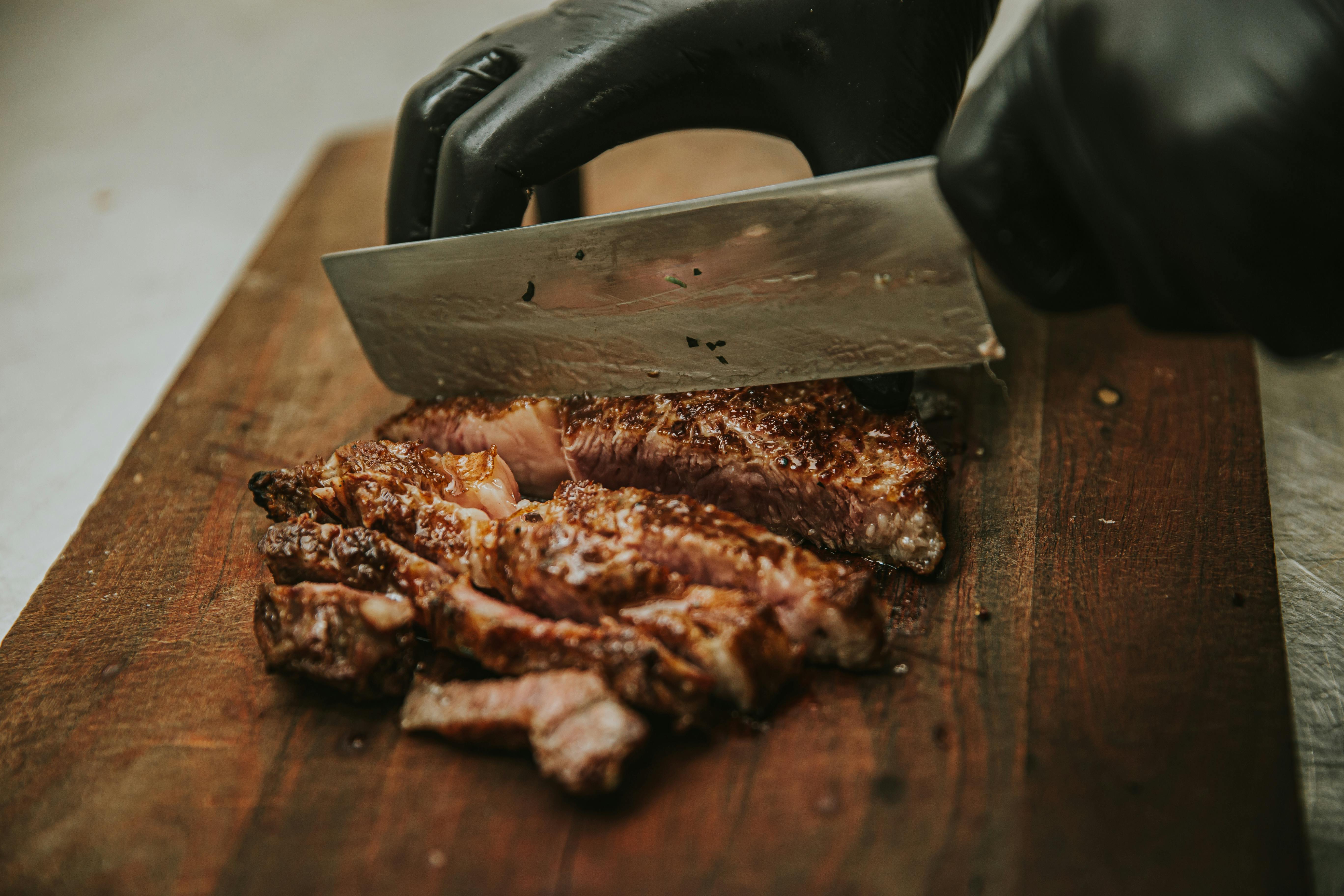Three Knives, One Goal: Making You Look Competent in the Kitchen
Chef’s Knife vs Santoku vs Cleaver
So, you want to choose the perfect kitchen knife? Congratulations, you’ve just entered a realm of cutthroat debates, overly opinionated chefs, and blade snobs who speak about edge retention with the same reverence others reserve for Renaissance art. The battle between the chef’s knife, santoku, and cleaver has raged for centuries (or at least since some dude on a cooking forum declared one of them “mid”). Each knife has its own strengths, weaknesses, and inherent personality—yes, knives have personalities, and if you listen closely, they whisper to you in the dead of night. Some whisper sweet nothings. Some whisper about the inevitable fall of civilization.
Let’s dive in.
Chef’s Knife (a.k.a. The Old Reliable, The French Mistress)

First up, the chef’s knife—the battle-hardened workhorse of Western kitchens, wielded with reckless abandon by everyone from Michelin-starred chefs to clueless college kids who think “julienne” is a girl they matched with on Tinder. This knife does it all: slicing, dicing, mincing, and if you’re in a pinch, fending off particularly aggressive produce.
The chef’s knife has a curved edge and tapered point. It’s designed for the beloved rocking motion, making it a dream for quick, fine chopping (think of rocking it like a baby crib back and forth over some cilantro). It’s a solid, all-purpose knife, and if you’ve practiced properly with it, it’s basically an extension of your hand.
Pros:
- Versatility incarnate. The chef’s knife is the Leatherman of knives—designed to do nearly everything passably well, from dicing onions to slicing meat to mincing herbs.
- Rocking motion for mincing. That curved blade makes quick work of herbs and garlic, turning them into tiny fragments of flavor with a rhythmic motion that makes you feel like a professional even if you’re barely holding it right.
- Decent weight distribution. Not too heavy, not too light. A good balance means you can cut without tiring out your wrist like some weak Victorian orphan.
- Tapered point for precision. Need to do delicate work like removing seeds from a pepper, deveining shrimp, or testing the doneness of meat in a completely irresponsible way? That point’s got your back.
- Time-tested design. There’s a reason this knife has been around forever. It just works.
Cons:
- Not a scooper. Sometimes you’ve chopped up a bunch of mirepoix and wish you could use your knife like a snow shovel to put all that goodness into the pan. A chef’s knife is just wide enough to tease you into trying this but not wide enough to do it well.
- Not the best for heavy-duty chopping. Smash through bones with it, and you’ll ruin the edge faster than a teenager ruins their first car.
- Meh for straight-down chopping. It excels at the rocking motion, but if you try to use it for straight vertical cuts, you might as well be using a butter knife. Every time I cut with this knife, it involves some sort of drag or slide.
Santoku (a.k.a. The Mom Favorite, The Fancy Cousin, The Knife for People Who Watch Too Many Cooking Shows)

Then there’s the santoku, which is really just a Japanese chef’s knife that went to finishing school. It has a straight edge, which means none of that rocking business—you’re chopping straight down like some kind of hyper-disciplined kitchen samurai. It’s shorter and lighter than a chef’s knife, which means using it feels a bit like wielding a kitchen fairy wand. Unfortunately, you can’t summon dinner with it—you still have to do the work. By the way, I have to point out that the reason I chose the picture above is because it’s a solid picture of a santoku. But let it be known, the technique used in that pictures is just awful.
Some people think the santoku is superior because it sounds exotic. The true benefit is it’s lighter, and therefore less tiring if you do a lot of lighter work like cutting through light meats and cutting herbs and fine vegetables. However, it gets less pleasant the more you work with pork and beef and the more you’re cutting carrots instead of cucumber.
Pros:
- Fast, precise, and lightweight. This knife is the culinary equivalent of a finely tuned sports car: zippy, controlled, and made for straight-down chopping. If you don’t want to learn the whole “rocking motion” thing, this is your knife.
- Great for vegetables. It absolutely destroys cucumbers, onions—just about anything that’s not meat or bones.
- Flat edge means full contact with the board. Flat edge means full contact with the board. Unlike the chef’s knife, where part of the blade might not make contact in a vertical cut, the santoku’s full-flat edge ensures a clean, even chop every time.
- Granton edge reduces sticking. Granton edge reduces sticking. The little dimples aren’t just for show—they actually help prevent food from clinging to the blade like an overly attached ex. This is something I was whining about just yesterday when I was using my classic chef’s knife to slice apples for a pie.
Cons:
- No rocking motion. If you want to mince garlic like a Food Network host, forget it.
- Shorter blade (usually). Shorter blade (usually). While some come in 8-inch versions, the standard santoku is around 6 to 7 inches, which feels a little dainty for serious butchering.
- Not great for large cuts of meat. You can slice meat, sure, but breaking down a chicken? Good luck with that.
- More of a specialist than an all-rounder. It’s amazing at some tasks, but if you need one knife to rule them all, the santoku isn’t it.
Chinese Cleaver (a.k.a. The Absolute Unit, The Kitchen Guillotine, The Okay Why Does That Look Scary)

Finally, we have the Chinese cleaver. It looks like it was designed for disassembling medieval knights rather than dicing onions, and yet here it is, one of the most refined kitchen tools on the planet. It can delicately slice a cucumber, then turn around and obliterate a chicken leg like it’s collecting a debt.
At first glance, the cleaver looks like it should be used for hacking through bones like some butcher in a low-budget kung fu movie, but in reality, it’s a graceful instrument that’s used for everything from paper-thin vegetable slicing to scooping up ingredients like a tiny kitchen bulldozer. The broad, rectangular blade might look intimidating, but it gives you control and efficiency once you get used to it. In some Chinese kitchens, it’s the only knife.
Pros:
- Extremely versatile in the right hands. This is the “one knife to rule them all” for much of East Asia. Meat, vegetables, herbs—you name it, the cleaver can handle it.
- Massive blade doubles as a scoop. Finished chopping? Just use the blade to shovel everything into the pan like a construction worker tossing gravel into a wheelbarrow.
- Weight does the work for you. Unlike the delicate finesse of a chef’s knife or santoku, the cleaver’s weight means you barely have to exert effort—it just falls through food with the force of gravity.
Cons:
- Learning curve. Switching to a cleaver feels awkward at first. You can use it for everything, but there’s a learning period where you’ll look ridiculous.
- Not great for delicate tasks. Want to core a strawberry or trim silver skin off a tenderloin? Good luck.
- Awkward for some hand sizes. If you have small hands or weak wrists, using a cleaver might make you feel like a child trying to swing a broadsword.
Verdict
Now, is one style of knife objectively better than the others? No, because this is the culinary world, where people will physically fight over whether pineapple belongs on pizza. But let’s be real: if you’re already proficient with a chef’s knife, switching to a santoku feels like swapping out your beloved car for a slightly different version with a weird gas pedal. The Chinese cleaver, though—that’s the real wild card to a Westerner like me. If you ever get the itch to expand your knife skills, it’s worth trying.
 Matthew Christensen
Matthew Christensen
Weekly Newsletter Contributor since 2023
Email the author! matthew@dvo.com
